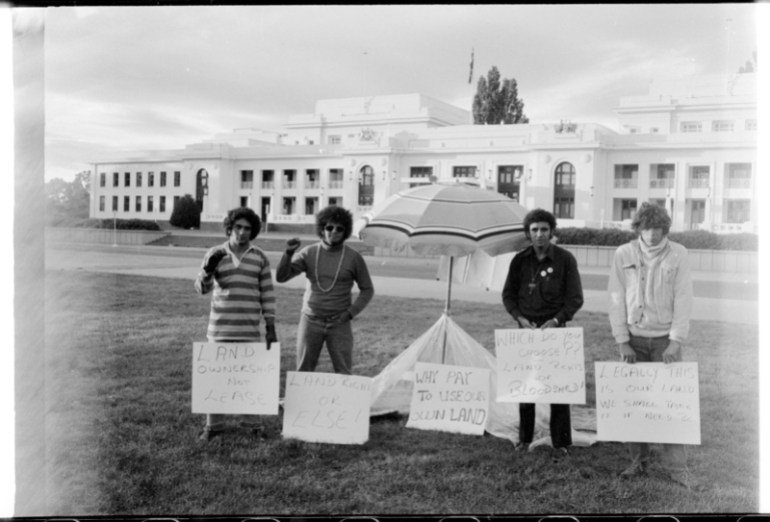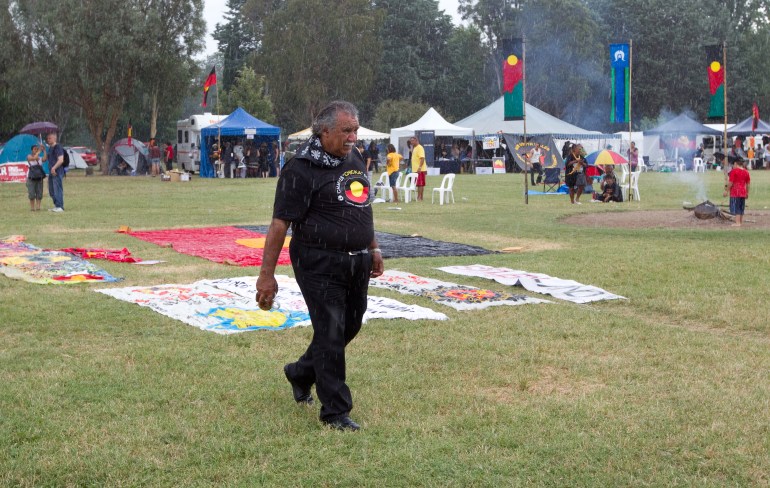Aboriginal Tent Embassy: 50 years of Indigenous protest
It started as a vigil but amid continued discrimination against Aboriginal Australians it has become one of the world’s longest protests.

It has stood for 50 years, one of the longest ongoing protests for Indigenous rights on the planet.
Yet the Aboriginal Tent Embassy, as it is known today, was originally intended to be a vigil.
Keep reading
list of 4 itemsWestern Australia extends COVID-era separation from country
Closed borders at the Australian Open
‘Scarred for life’: Australia COVID wave heaps pressure on nurses
“Truth be known it wasn’t originally intended to be an embassy. We went down there to have a permanent vigil,” founder Ghillar Michael Anderson, who is now 70, told Al Jazeera.
“When we got to Canberra we just said, ‘Well, basically it’s going to be a permanent vigil and if people ask us what it’s about, it’s about land rights and we are now squatting on this land and we have taken the land back just like the whitefellas.’”
It was the 26th of January 1972, the date for the official commemoration of the founding of the colony of Australia.
On the grass in front of Parliament House, four young Aboriginal activists planted a beach umbrella and erected a hand-made sign: ‘Aboriginal Embassy’.
The four young men – Anderson, Billy Craigie, Bertie Williams and Tony Coorey – felt it was necessary to make a public statement on the plight of Indigenous peoples across the continent.
“As soon as the name embassy was written up and hung up there and they saw it the next day, it resonated with a lot of people around the world,” Anderson said.
“The embassy itself was basically a representation for all [Indigenous] nations. We set it up so that little block of land that we squatted would be seen as neutral land where Aboriginal people could come and voice their opinions about the occupation that we were under from the British.”

A Euahlayi and Gumilaroi man, Anderson grew up in the small rural town of Walgett, nearly 650 kilometres northwest of Sydney, at a time when the marginalisation of Indigenous peoples was extreme.
Despite his parents living in “tin shacks on the banks of the Namoi river” Anderson succeeded at high school and moved to Sydney in 1969 to attend university.
It wasn’t long before he connected with like-minded young Aboriginal activists and “because we were all like-minded it didn’t take us long to start a movement.”
“We basically hi-jacked the Vietnam march,” he told Al Jazeera. While the Aboriginal activists acknowledged the injustice of the Vietnam War, they pointed out that “they are still killing us on our own land.”
“So we turned the mentality of a lot of those University students around to focus on Land Rights in Australia and to stop killing Aborigines.”
Shocked to action
The establishment of the Aboriginal Tent Embassy in such a prominent place – Australia’s Parliament House – was vital in the success of drawing attention to a range of issues voiced by the protesters, such as land rights, self-determination and sovereignty, he says.
“All these foreign dignitaries used to come to the parliament and they’d drive past and see this embassy sitting there asking those questions. So, we became an embarrassment for the Australian government in international eyes,” Anderson recalled.
“What it did was that it shocked Australia into having to deal with issues that had been left unresolved.”
The group was invited to a range of international embassies, where foreign officials wanted to discuss the issues facing Indigenous peoples.
“That was the impact that it had. It really struck at the very heart of Australia’s so-called peaceful existence. And then, all of a sudden, the embassy and our presence opened this wound they’d been hiding from the general public. And then the international media focused on this and said, ‘Well, hang on a minute, what the hell is all this about?’’”
While the Embassy quickly attracted a growing number of young activists who would go on to become prominent Indigenous voices in Australian politics – including Gary Foley and Isabel Coe – it was met with resistance from the government and police, with attempts to break it up and move protesters on.

However, the Aboriginal Tent Embassy, as it became known, remained, and continues to play a central role in the politics and activism of Indigenous peoples from around the country.
Hope for the future
Dhani Gilbert is from the Kalari (Lachland River) and Wiradjuri peoples and grew up with her family being an integral part of the Tent Embassy.
The 20-year-old is determined to continue the fight for justice.
“One thing that always came through for me growing up at the Embassy was this hope for moving forward and this hope for a better future,” Gilbert told Al Jazeera.
“We can only really achieve things if we stand together as a strong community.”
She says that the continued existence of the embassy is a testament to the lack of progress resolving the ongoing issues affecting Indigenous peoples.
It is important there is a “growing understanding nationally and internationally of what the Aboriginal Tent Embassy stands for and why having a place that is the oldest protest site in the world is so significant and what it tells you about Australia’s lack of action,” she said.
“While the Embassy has achieved a lot, it’s not yet where those four men and the people that supported them have hoped it would be,” she said.
In particular, Gilbert acknowledges that Indigenous land rights are intrinsically linked to environmental justice, and that Indigenous people continue to face high rates of incarceration and deaths in custody.

Currently, despite making up only 3.3 percent of the population, Indigenous people make up more than 28 percent of the people in Australia’s prisons.
While acknowledging the importance of the previous 50 years, Gilbert is determined to ensure the Aboriginal Tent Embassy remains a central focus for Indigenous activism.
“Coming up to the 100th anniversary I would hope by then that we’ve seen some serious change in our attitude towards First Nations’ People and First Nations’ justice.”
Founding member Anderson agrees.
“We haven’t gone anywhere near resolving the issues,” he said. “There’s a lot of facades that have been put up, but when you go beyond those facades you begin to realise that Aboriginal people are worse off now than what they ever were.
“My job is not finished. We still have a long way to go.”